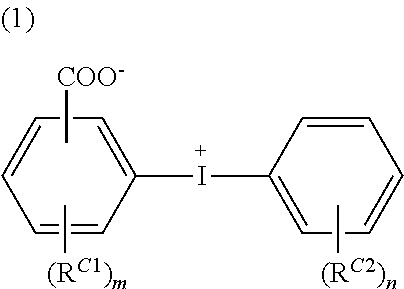Conductive polymer material and substrate
a technology of conductive polymer material and substrate, which is applied in the direction of non-metal conductors, conductors, organic conductors, etc., can solve the problems of agglomeration of particles with the passage of time, and achieve excellent conductivity and transparency, improve the conductivity of the present invention, and improve the conductivity of the material
- Summary
- Abstract
- Description
- Claims
- Application Information
AI Technical Summary
Benefits of technology
Problems solved by technology
Method used
Image
Examples
synthesis examples 1 to 15
[0135]Under nitrogen atmosphere, a monomer was dissolved in methanol stirred at 64° C., and to the obtained solution was added dropwise a solution in which dimethyl 2,2′-azobis(isobutyrate) had been dissolved in methanol, over 4 hours, followed by stirring for 4 hours. After cooling to room temperature, the mixture was added dropwise to ethyl acetate under vigorous stirring. The resulting solid was collected by filtration, and dried under vacuum at 50° C. for 15 hours. The resulting white polymer was dissolved in methanol, and then a cation of the monomer was exchanged with a hydrogen atom by ion-exchange resin to convert into a sulfo group.
[0136]In such a method, the following Dopant polymers 1 to 15 were obtained.
[0137]Weight-average molecular weight (Mw)=46,000
[0138]Molecular weight distribution (Mw / Mn)=1.55
[0139]
[0140]Weight-average molecular weight (Mw)=41,000
[0141]Molecular weight distribution (Mw / Mn)=1.66
[0142]
Dopant Polymer 3
[0143]Weight-avera...
preparation example 1
[0182]A solution in which 12.5 g of Dopant polymer 1 had been dissolved in 1,000 mL of ultrapure water was mixed with 3.82 g of 3,4-ethylenedioxythiophene at 30° C.
[0183]Into the resulting mixed solution was slowly added an oxidation catalyst solution in which 8.40 g of sodium persulfate and 2.3 g of ferric sulfate had been dissolved in 100 mL of ultrapure water while stirring the mixed solution and keeping the temperature thereof at 30° C., and the reaction was carried out for 4 hours under stirring.
[0184]Into the reaction solution thus obtained was added 1,000 mL of ultrapure water, and about 1,000 mL of the solution was removed by ultrafiltration. This procedure was repeated 3 times.
[0185]Subsequently, 200 mL of sulfuric acid diluted to 10% by mass and 2,000 mL of ion-exchanged water were added to the solution treated with the ultrafiltration, and about 2,000 mL of the treated solution was removed by ultrafiltration. After 2,000 mL of ion-exchanged water was added thereto, about ...
preparation example 2
[0194]Procedure of Preparation Example 1 was repeated, except that 10.0 g of Dopant polymer 2 was used in place of 12.5 g of Dopant polymer 1, the blending amount of 3,4-ethylenedioxythiophene was changed to 2.41 g, the blending amount of sodium persulfate was changed to 5.31 g, and the blending amount of ferric sulfate was changed to 1.50 g, to obtain Conductive polymer composite dispersion 2.
PUM
| Property | Measurement | Unit |
|---|---|---|
| absorption at a wavelength | aaaaa | aaaaa |
| temperature | aaaaa | aaaaa |
| reaction time | aaaaa | aaaaa |
Abstract
Description
Claims
Application Information
 Login to View More
Login to View More - R&D
- Intellectual Property
- Life Sciences
- Materials
- Tech Scout
- Unparalleled Data Quality
- Higher Quality Content
- 60% Fewer Hallucinations
Browse by: Latest US Patents, China's latest patents, Technical Efficacy Thesaurus, Application Domain, Technology Topic, Popular Technical Reports.
© 2025 PatSnap. All rights reserved.Legal|Privacy policy|Modern Slavery Act Transparency Statement|Sitemap|About US| Contact US: help@patsnap.com



